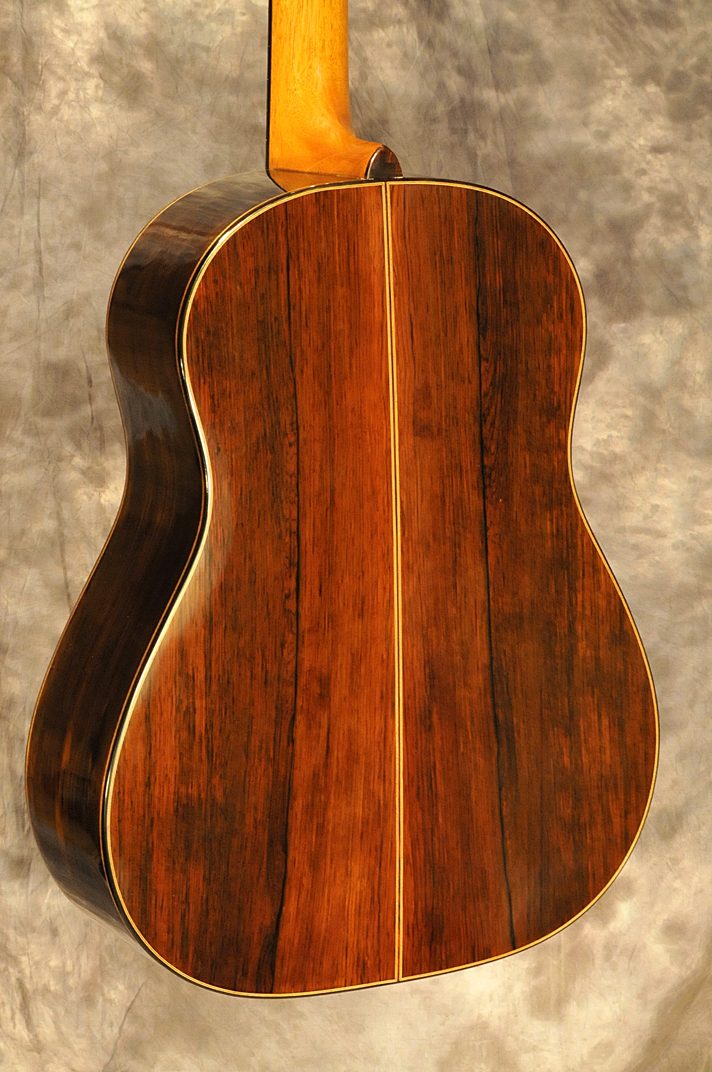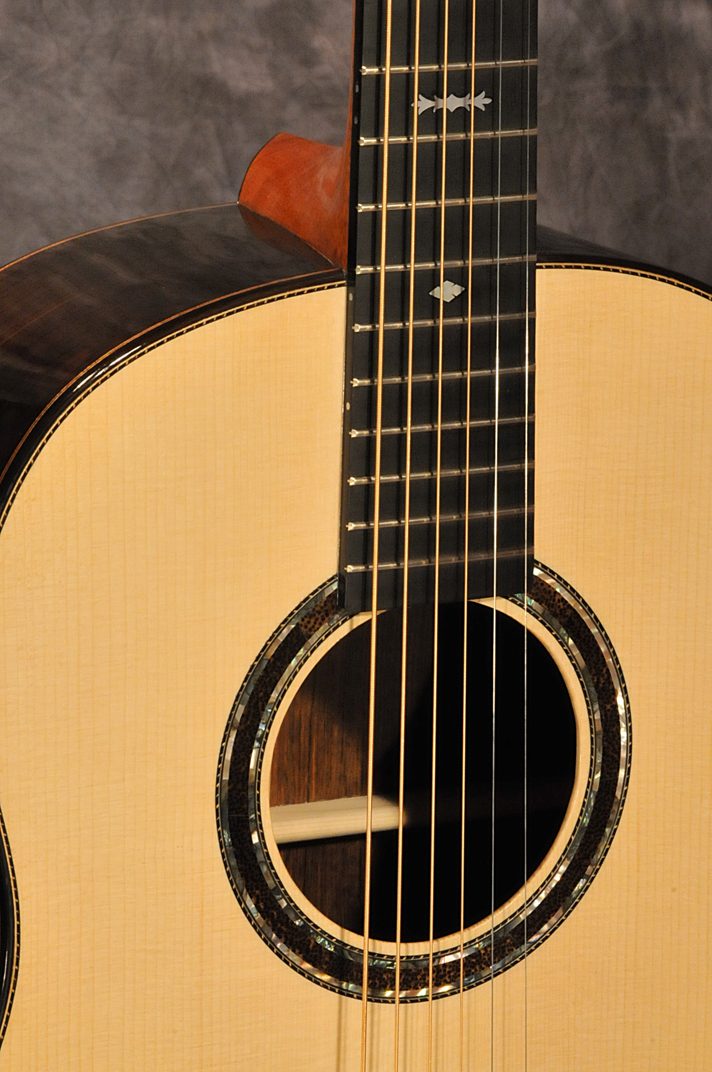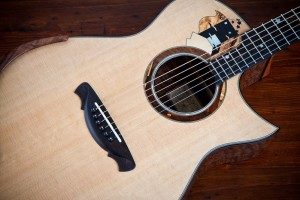I remember my first telephone conversation with Dake Traphagen. I admit, I was a little nervous to call him — maybe it had something to do with that imposing last name. Traphagen… It just sounded tough, and to the point.
Frankly, I don’t know exactly what I expected, but to me “Dake Traphagen” sounded more like the name of a European action star than the name of a builder of fine guitars.
Okay, jokes aside, my reticence to call him seems pretty silly to me now. A few minutes into our telephone conversation, I realized that Dake is one of the smartest, insightful men I have ever had the pleasure to speak with – a real fountain of knowledge, about life, politics, history, and of course guitars.
For almost 40 years, classical guitarists have known what steel string guitarists are only now discovering — Mr. Traphagen builds extraordinary musical instruments. These are the kind of guitars that become an extension of your musical being, the kind that you bond with – guitars you can’t bear to be without.
Recently, Dake began offering his very special steel string guitars to the general public. Once, these guitars were the exclusive treasures of his friends and very close associates — but now, to the good fortune of acoustic guitarists everywhere, you can get your very own.
It is a real honor to present the following interview with Dake Traphagen. Thank you Dake, for your generosity, knowledge and candor.

DAKE TRAPHAGEN
You are primarily known for your classical guitars. Why have you decided to bring steel strings into the market at this point in your career?
I have made steel strings all along, but mostly for friends or friends of friends. I decided to jump in full bore because I really enjoy the creativity of all the different models I make, as well as being inspired by many of the fine players now playing these instruments.
The attention to tonal colors and musical nuances now being used is fantastic — and an inspiration to build for. Also, the level of workmanship and design in the steel string world is phenomenal, a real inspiration. How could I not want to add my little part to this renaissance?
Who did you apprentice with? And what did you take away from that experience?
My first apprenticeship was with a violinmaker and restorer/repairman named Ed Hunntington, in California. He was a superb repairman and restorer to whom I owe a great debt of gratitude. I was a violinist at the time, but when he saw my hands he said, “you have workman’s hands” — and in the end he was correct.
Five years later I studied in Holland with Nico van deer Waals. He is a master guitar and lute maker. I worked with him for several months in Europe, and when he took his vacations in the USA, we would work together in my shop. This went on for a few years, and we always inspired each other to look deeper into the how these wonderful instruments actually worked, how they were made, and their sound. Nico and I enjoyed a deep friendship.
You are known for having an incredible supply of Brazilian Rosewood, some of which is over 150 years old. How does the stability of this premium grade wood differ from the highly figured crotch/stump wood many builders are using these days? And is there a significant tonal difference?
I’m fortunate to have a good friend in Brazil whom I’ve visited several times. We would go to salvage yards and find gems in the rough. Sometimes we find Brazilian rosewood beams, which we’ve since carbon dated.
The oldest one so far was cut in 1786. I currently have wood from beams dated 1887 and 1904. Some of the stump wood is quite old as well, late 1800’s, and it is excellent tone wood.
I use a heat press to pre-stress all my backs to make sure they will remain as stable as possible throughout the life of the guitar which it is used in.
This very old wood just seems to have a magic to it. I know that sounds a bit corny, but each guitar I make with this wood turns out be really special. It’s a mystery to be sure.
Tell me about your new website.
The updated website has many more photos, and has been divided into a steel string section and a classical/nylon string section. I’m working to get many more sound clips, which I hope will be coming soon. At least the players say they are!? As with most web sites if you want to keep them current it’s going to be a continual work in progress.

Dake in the shop.
I am particularly fond of your dreadnoughts – they have amazing headroom for the flat-picker, yet sound great when softly fingerpicked. How do you build a large body guitar that has such great dynamic range, and is not just a cannon?
All of my guitars are considered to be loud — and I could make them even louder,
but I feel the musical quality of the instrument is lost when you just go for
volume. I have been using a different bracing pattern on many of these guitars,
which is a modified standard ‘X’ bracing and lattice bracing combination.
This bracing design produces a guitar that has a very nuanced sound, capable of a wide color pallet, and excellent dynamic range. It’s an exciting change from the ‘standard’ bracing pattern we all know and love. Also, I just get lucky sometimes. The harder I work the luckier I get.
I’ve heard your name pronounced a variety of ways: Trap-hag-in, Traf-hagen, etc. Which is correct?
Here in the good ole USA it’s pronounced Trap-hagen (long a as in day). In the old country it would sound like Trop-haugen.
Can you explain how you make double tops for your guitars, how they differ from other double tops, and what they bring to the sonic equation?
The double top, or ‘sandwich’ top, has been a design feature in classical guitars for the past 20 years or so. The salient point of a double top is the weight to strength ratio. A well-designed and constructed top is 15% -20% lighter in weight than a traditional top, yet has the strength of a solid top. This is true with both classical and acoustic guitars.
The actual mechanics of a double top, the way the top moves when a string is activated, is also different than solid wood. It moves/pumps more as a cohesive unit than a solid top, thus influencing the overall sound to be more even and full, and usually a bit louder than solid wood.
My construction method is quite complex — with the use of a router and outline gig to cut the cavity where the Nomex will be glued, and using a vacuum clamp system to glue the Nomex to the inside. There are strategic places in the main core of the top that are still solid wood which helps the overall structural integrity of the top. I use different configurations in the wood core depending on the size and shape of the guitar.
So far I have used it for classical guitars, ‘OO’, ‘OOO’ and my concert model steel strings. I’m not sure yet if it’s appropriate to use it on large bodies such as a jumbo or Dred size guitar. I’m going to have to make one and see how it turns out. If it works well, then I think it would make a great finger style jumbo guitar.
I’ve recently seen one your guitars with stunning Myrtle wood back and sides. What tonal characteristic does this wood have?
Flamed Tasmanian Myrtle wood is visually a very striking wood. It’s overall weight and sound characteristics lie somewhere between Indian rosewood and Mahogany. It’s fairly easy to work with, and I look forward to using it on future guitars.
In addition to Myrtle wood, what are some of the alternatives you have to offer clients, beyond Brazilian, Indian, and Mahogany?
In the rosewood family, Honduran Rosewood is my second choice to Brazilian. Panamanian Rosewood is also acoustically very similar to Brazilian, but it is rare to find, and often light in color — which is not that appealing to people who are used to seeing dark rosewoods. If it was readily available, I wouldn’t hesitate to use it. It makes great sounding guitars.
Spanish Cypress is also one of my favorite back and side woods. Most people think of it as only being used in flamenco guitars but it works great for standard classical guitars, and I look forward to using it on a steel string before long.
Is all Brazilian Rosewood equally appropriate for classical guitars, and steel strings? That is, will a great set of wood for a classical guitar automatically mean the wood is great for a steel string? Or do you look for different properties, even within the same species of wood, which make it more appropriate for specific guitars?
In general great wood is great wood for any stringed instrument. That being said, there are some sets of Brazilian that are so heavy I would prefer to use them on a larger body steel string guitar rather than a classical or small body acoustic. Great Brazilian Rosewood is rare, and if thicknessed appropriately, it should make a great guitar of any style.

You’ve developed a unique hybrid bracing system for your steel string guitars. Can you describe the way you brace, and why you’ve come to believe that this is the best way for you to do it?
I referred to my bracing system earlier, but prefer this hybrid ‘X’ lattice design because of the way it distributes tension evenly over the entire top. It seems to activate the top more as a whole unit, as opposed to the various tone bars for specific areas in the traditional design.
I still make traditionally braced steel strings for those wanting that ‘traditional’ sound, but usually I use this hybrid system when I’m free to make the guitar the way I choose.
I don’t see Sitka spruce available as an option on your website? Is this an intentional omission? Do you build with Sitka?
Well, this may rub some people the wrong way but I just don’t like the sound of Sitka spruce. In general it is much too dense for classicals and has a rather generic sound on steel strings.
I much prefer the spruces from Europe, with all their variations. Northern Italian spruce is quite different from the Swiss ‘moon’ spruce. Carpathian spruce has its own voice and is different from German spruce. Adirondack spruce has its own character as well, and is actually quite similar to the Carpathian spruce in my view.
Depending on the sound a client is requesting, I can use these different spruces to help achieve the voice the player hears in their head.
Do you use hide glue? Why or why not?
I do use hot hide glue, as well as fish glue, which is very similar in strength and hardness. I always use it with everything having to do with the top. Sometimes I’ll use it for the entire instrument. I prefer hot hide glue or polyurethane glue for the fingerboard, as it will not ‘creep’ under extreme climate conditions.
I often use clear aliphatic resin glue, like Titebond but clear, for the back and linings. It goes on very cleanly and cleans up easily too, When you look through the sound hole you don’t see any excess glue, which is difficult to clean off when it’s hide glue.
I’ve never asked you this before — are you a good guitar player? Do you think being a player is essential to becoming a great builder?
I do play some. Not as much as I used to as my hands are a bit ‘used’ from building for so many years. It will be 40 years next year, yikes! As my violinmaking teacher told me “you have workman’s hands”.
I have played many different instruments over the years, mostly strings and keyboard, and I do think it helps to be ‘musical’ in order to make a fine guitar. Historically however, luthiers usually didn’t excel at playing the instruments they made. For instance, a violinmaker may have been a very good horn player and so on.
I am intrigued by your French Baroque guitar. Is it based on a specific historical instrument, or is it your interpretation of that style?
There are two Baroque guitars on my website. One is in the guitar section and another in the slide show. The one in the guitar section is a copy of a French Baroque guitar in the Victoria Albert museum in London built by Jean Voboam. I had the pleasure of handling this guitar and measuring it while I was visiting London.
The other is an Italian Baroque guitar based on a guitar by Mateo Sellas, which I measured and cataloged while visiting the Brussels Conservatory of Music in 1975.
The tunings and double stringing are different between the two as well. In the early music scene, players want historically accurate instruments in order to play the repertoire as closely as possible to the way it would have been played back in its day. I rarely make these instruments anymore, as the decorative work becomes rather tedious and laborious. It was very exciting the first few times I did it, now however I know how much time it’s going to entail so I shy away from it.
What sets Traphagen guitars apart from other custom and high-end hand built guitars?
Each builder has their own unique sound, and works in a way that makes sense to them. It is nearly impossible for me to copy another builder’s guitar and expect it to sound exactly the same — and vice versa. We luthiers are, in a way, stuck with our own voices/sound. Sometimes that is a little frustrating if you’re trying to make big changes in ‘your’ sound.
I’ve done a lot of experimenting with top bracing for instance — sometimes radical changes — and in the end they will have slightly different characters. Overall though, they still sound like one of my guitars.
I once had and apprentice who was making some nice guitars. We decided we would make identical guitars using wood cut from the same boards, using the same tools, in the same shop environment, with the same design/plan etc.
In the end you could tell the two guitars were related, but his sounded like his and mine sounded like mine.
My guitars are known for their volume and beauty of tone. If this is what a player is looking for, then they’ll love my guitars. Also, having nearly 40 years experience doesn’t hurt.

The luthier's workbench.
What advice would you give to someone who is considering a career in luthiery?
If you don’t get consumed/obsessed by it then it’s not for you. This craft takes complete dedication and it’s hard work as well. You’ll spill a lot of blood, sweat, and tears – literally – in the pursuit of becoming an accomplished luthier.
Also, start off with a standard tried and true pattern and bracing system. I’ve seen many novice builders think they are going to change the guitar world with some clever design, only to find that they didn’t really understand the basic mechanics of how a guitar produces sound in the first place.
Many builders say you won’t really understand what’s going on until you’ve built at least 100 guitars. I think that time frame has been shortened a bit because there is so much more information readily available now, as opposed to when Istarted back in the dark ages. However, hands on experience is still the best teacher – as long as one is paying close attention to what their doing.
Even after all the hours and years I’ve put into guitar making I’m still learning little things I didn’t realize before. It becomes a way of life, not just a job or ‘product’.
Do you have any final thoughts for the readers of our blog?
For me building guitars has been, and still is one, of the most gratifying pursuits I can imagine. Each day I thank everyone who has helped me along the way to becoming a better builder and having such a fantastic ‘job’.
Please don’t call your guitars a ‘product’. I feel it is an insult to the builder, and to the amazing musical instrument that is the guitar.
I also want to thank you Steven, and Paul, for believing in my guitars and for giving me the chance to share a few thoughts about my instruments. Good luck to everyone who is building or wants to build these beautiful musical tools, and to the players that make us luthiers sound so good.
























































 demonstration
demonstration


















































